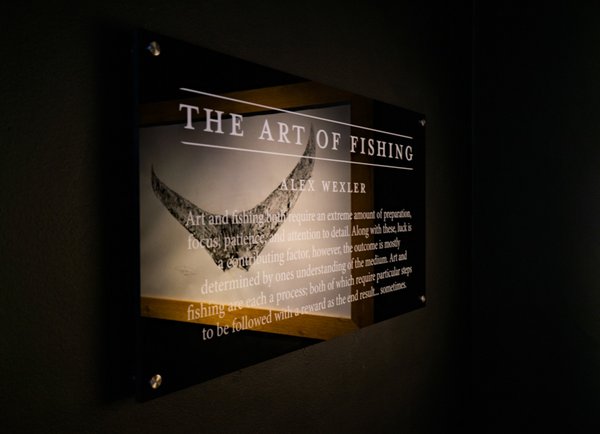



452lb Swordfish Tail
47 1/2” x 33 1/2”
(Xiphias gladius)
The Swordfish is one of the most noble fish there are. They are apex predators that occupy a very unique ecosystem. They prefer deep water near canyons and valleys in the 1200-2000 foot range. They are highly migratory and it's difficult to know where the fish move due to a lack of tagging data. What we do know however, is that they come near the surface at night and prefer feeding near the bottom during the day.
This particular fish was caught aboard the “Double Threat” a charter boat out of Miami. The following is a recount from the Captain of the boat Capt. Nick Gonzalez. It is one of the most incredible swordfish stories I have ever heard and I was honored to be able to print the tail. I took 3 prints off and this is the only one that remains.
“Simply put, most epic fight I've ever experienced.
We took 2 drops without a bite but we had a patient crew and just kept at it. On our 3rd drop, the tip rod piled over and started ripping line with violent head-shakes. Most XL swordfish will "slack you," which involves swimming a 10lb lead straight to the surface like it's nothing. After about 2 minutes of dogging us, this fish did exactly that. She started racing to the surface as fast as we could back down and retrieve the line.
Swordfish have soft mouths and many fights end in heart-break with pulled hooks for exactly this reason. To help increase our closing ratio on big swords, we always have 2 harpoons ready and try "darting them" as soon as possible.
This fish came straight to the surface and gave us exactly the shot we were looking for. Kris, the mate, hit her with the harpoon within 15 minutes of first hooking her. The fish quickly realized what was going on and started running straight back to the bottom. After taking 500 feet of line, the hook pulled and all we had left was the dart tethered to a giant swordfish that was really pissed off. Just like hooks, darts notoriously pull out of swordfish, especially during long fights. The fish took 1,000 feet of harpoon line which we attached to a 130 pound Penn International. She then continued taking about 500 more yards and stopped when she got to the bottom.
We didn't know where we hit the fish. The dart could have barely graced her and we knew things weren't looking good. We had a swordfish about 2,000 feet down dragging around a harpoon, 1,000 feet of rope, and no hook.
We slowly began inching the fish back up and incrementally increasing drag. To be honest, our expectations were pretty low. We had a long way to go and we were ready for the dart to dislodge itself at any moment. I began mentally preparing with losing this fish but kept it to myself. We just played her our as best we could and hoped for the best.
We spent a total of 5 hours pulling this fish back up inch by inch. We spent most of the time manually cranking with up to 40lbs of drag and had to do the last 1,000 feet by hand. When we finally saw the fish again it almost didn't seem real. The fish looked about 400-500 lbs and was being pulled up sideways by our dart. As soon as she was in range we hit her with another harpoon and a flying gaff. We were all exhausted, relieved, and stoked at the same time. We could barely get the fish into the boat and had to use 3 people as well as a block and tackle. Swordfish are heavy for their size and extremely awkward with their giant bills and tails. When she finally hit the deck, we were ready to go home and weigh her. She was 452 lbs and over 10 feet long. She even had bright orange meet which is considered a "pumpkin." We stayed late cleaning the fish and there were plenty of steaks for everyone. This fish is definitely burned into my memory.”
- Capt. Nick Gonzalez of Double Threat Charters
https://www.fishmiamicharters.com/
